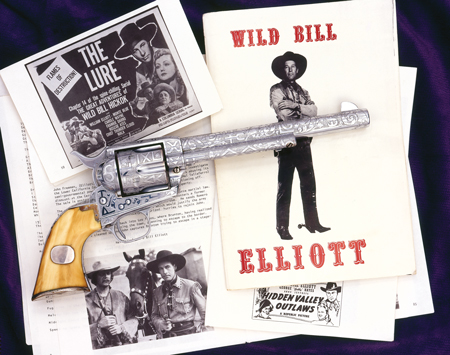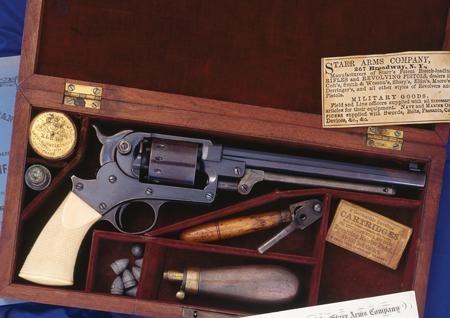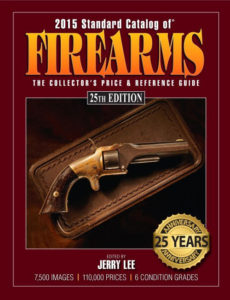
The hazard of fire is also ever-present. Not a few articles have been written on insurance; the subject is well covered in the James E. Serven book The Collecting of Guns and in several American Rifleman articles. In broadest terms, antique and collectors’ firearms are not best covered under the most commonly used “Home Owners” policies.
In most circumstances under that type coverage, a maximum fixed percentage (usually 10 percent) of the total value of the policy would apply to items such as firearms. Also, a limit or maximum dollar value would be set for any one piece, coverage generally applies only to guns actually on the premises and claims most often are paid on an actual cash or cost basis or even according to replacement cost less depreciation.

Establishing some of these factors often entails considerable administrative as well as emotional problems after a loss has occurred. Special waivers and riders can cover some contingencies, but experience has shown that collectors rarely bother to adequately investigate their coverage for antique and collectors’ guns under a Home Owner’s policy.
The result is very much a case of closing the barn door after the horse has gone. One of the best and broadest types of coverage for antique and collectors’ firearms is under policies known as “Fine Arts Floaters.” Any good, knowledgeable insurance agent will be familiar with them. A number of attractive plans are even offered by some of the larger collecting organizations.
The key feature of the Fine Arts policy is the fact that each and every gun in the collection is itemized and valued and kept on record with the insurance company and agent. These policies normally have provisions allowing for coverage even when the guns are on exhibit at a show and in transit. Should a loss occur, settlements are normally quicker and are generally for the amount on the scheduled list.
It is, of course, quite necessary to continually update the schedule as prices change, or as items are bought or sold. Coverage under Fine Arts policies has not only been found to be broad in scope, but often features advantageous rates. They are well worth investigating.

APPRAISALS
Professional appraisals are often important in establishing values for antique and collectors’ guns. Such evaluations are specified requirements for some insurance policies, for any estate and gift tax purposes, for tax plans of various types and damage and loss claims. They play an important role in determining originality of a collector’s item, by supplying a professional opinion in writing.
The key to acceptability of the values or opinions stated in an appraisal by the party to whom they are submitted are the credentials and background of the appraiser. It is a simple matter to find anyone with the slightest knowledge of guns and have them write an evaluation, pulling figures out of the air so to speak; all that is needed is a typewriter and paper.
However, the collector should well understand and remember that those evaluations are subject to review by quite a few official parties before acceptability and that one of the major features scrutinized is the credentials of the appraiser; his experience within the field of guns (not merely a general antiques appraiser) and his reputation are principal factors.
Major appraisers associations are able to furnish lists of recognized experts whose specialty is firearms. A number of well-known dealers in the antique arms field are quite well qualified and handle evaluations as part of their normal business routine. Appraisal fees vary considerably and are dependent upon the qualifications and credentials of the appraiser, his expertise and professional affiliations, and, of course, his location.
Fees are often based upon hourly and daily rates or on a flat rate based on quantity involved. The common practice of charging a percentage of the appraised value of the item or collection is looked upon unfavorably. It is no longer in use by most major auction houses and is actually forbidden in the bylaws of some major appraisers’ associations.
Editor's Note: This article is form Flayderman's Guide to Antique American Firearms.
2015 Standard Catalog of Firearms, 25th Edition
The 2015 Standard Catalog of Firearms, 25th Edition is the preferred desk reference guide to the realm of antique, vintage, and modern firearms from around the world, and is now in its 25th edition with more than 26,000 listings of collectible and modern firearms. This industry-leading reference on firearms valuation and pricing has everything you need, whether you’re looking to buy, sell, or collect firearms.


![Best Concealed Carry Guns In 2025 [Field Tested] Wilson Combat EDC X9S 1](https://gundigest.com/wp-content/uploads/Wilson-Combat-EDC-X9S-1-324x160.jpg)


![Best 9mm Carbine: Affordable PCCs [Tested] Ruger Carbine Shooting](https://gundigest.com/wp-content/uploads/Ruger-Carbine-Shooting-100x70.jpg)
![Best AR-15: Top Options Available Today [Field Tested] Harrington and Richardson PSA XM177E2 feature](https://gundigest.com/wp-content/uploads/Harrington-and-Richardson-PSA-XM177E2-feature-100x70.jpg)
